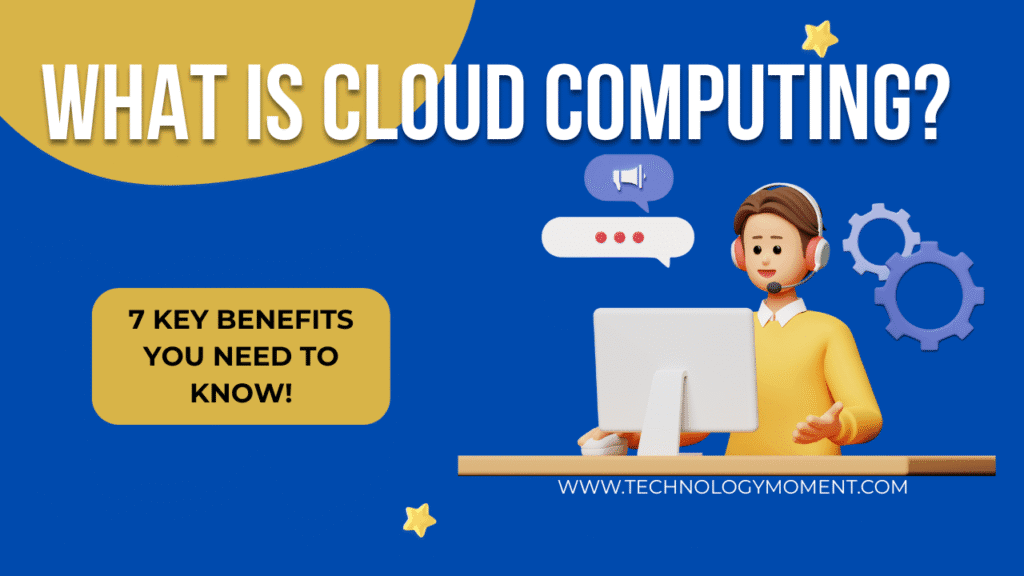
Welcome to Technology Moment, your go-to hub for breaking down complex tech trends into simple, practical insights. In today’s post, we’re diving into one of the most game-changing innovations shaping our digital lives: cloud computing.
Whether you’re a business owner trying to cut costs, a student exploring the tech world, or simply curious about where your favorite apps “live,” understanding cloud computing is essential. In this article, “What is Cloud Computing? 7 Key Benefits You Need to Know!”—We’ll start with a crystal-clear introduction to cloud computing before unpacking its biggest advantages. By the end, you’ll see exactly why the cloud isn’t just a buzzword but the backbone of modern technology.
What is Cloud Computing?
Cloud computing might sound complex, but at its heart, it’s simply using the internet to access computing resources instead of owning them outright. Imagine you need electricity. You don’t build your own power plant; you connect to the grid and pay for what you consume. Cloud computing works the same way for IT resources. Rather than buying servers, installing software, or hiring a large IT team to maintain them, you “rent” computing power, storage, and applications from providers who run huge data centers around the world.
This approach is revolutionary because it eliminates geographic barriers. A small startup in Kenya, a multinational in Germany, and a student in India all have the same ability to tap into powerful cloud services within minutes. Cloud computing democratizes technology, putting enterprise-level tools into the hands of everyone—globally, not just in tech hubs.
Another key point is flexibility. Traditionally, you needed months of planning to add new IT infrastructure. With cloud computing, you can deploy services in hours or even minutes. This makes it easier for businesses to innovate quickly and respond to changing customer needs, no matter where they’re based.
Table of Contents
Core Components of Cloud Computing
Cloud computing isn’t one single product—it’s a collection of services organized into layers. Understanding these layers helps you see why the cloud is so powerful.
Infrastructure as a Service (IaaS)
IaaS is the foundation. Think of it as renting the virtual equivalent of servers, storage, and networks. You don’t need to buy physical machines or set up networking gear; your cloud provider handles it all. Businesses worldwide use IaaS to spin up virtual machines, host websites, and store massive amounts of data without the cost of owning physical data centers.
Platform as a Service (PaaS)
The above infrastructure is the platform layer. PaaS provides an environment where developers can build, test, and deploy applications without worrying about servers, operating systems, or storage. It’s like having a workshop ready to go—tools, benches, and safety gear included. This speeds up development, reduces costs, and allows teams across the globe to collaborate seamlessly.
Software as a Service (SaaS)
At the top is SaaS—software you access over the internet instead of installing on your own machines. Think of tools like Google Workspace, Salesforce, or Zoom. You log in from any device, anywhere in the world, and instantly have access to powerful applications. SaaS makes it easy for companies of all sizes to use advanced software without managing upgrades or security patches.
Together, IaaS, PaaS, and SaaS form the backbone of modern digital services. Understanding these components helps you see why companies in every country—from small online shops to Fortune 500 giants—are moving to the cloud.
7 Key Benefits of Cloud Computing
1. Cost Savings
Traditional IT requires upfront capital: buying servers, setting up data centers, and hiring IT staff. Cloud computing turns this into a predictable operating expense. You pay only for what you use—like a utility bill. This is especially powerful for small businesses or startups globally because it removes the financial barrier to entry.
2. Scalability and Flexibility
Cloud services scale almost instantly. If your e-commerce store suddenly goes viral and traffic triples overnight, you can expand your cloud capacity with a few clicks. When demand drops, you scale back down. This elasticity ensures you’re never overpaying or under-prepared.
3. Enhanced Collaboration
Cloud computing breaks down borders. Employees in different countries can work on the same files, applications, and projects in real time. Whether you’re in Brazil, Canada, or South Africa, everyone accesses the same up-to-date information, improving productivity and reducing confusion.
4. Business Continuity and Disaster Recovery
Natural disasters, cyberattacks, or hardware failures can cripple on-premises systems. Cloud providers spread your data across multiple, secure data centers worldwide. This redundancy ensures your information and applications remain available even if one location experiences problems—an essential advantage for global operations.
5. Automatic Updates and Maintenance
Cloud providers handle software updates, security patches, and hardware upgrades behind the scenes. This saves you time, money, and stress. Your team can focus on growth and innovation rather than routine IT maintenance.
6. Global Accessibility
The cloud lives online. As long as you have an internet connection, you can access your data and apps from anywhere—whether you’re at an airport lounge, a café, or your office. This global accessibility empowers remote workforces and opens up international opportunities.
7. Improved Security
Major cloud providers invest heavily in cybersecurity, often more than individual organizations could afford. They deploy advanced encryption, firewalls, and continuous monitoring to keep your data safe. Plus, many offer compliance certifications that meet strict global standards—critical for industries like finance or healthcare.
Real-Life Examples of Cloud Computing in Action
Cloud computing isn’t just a buzzword—it’s powering some of the biggest changes in our daily lives and businesses. Take small businesses for example. A local bakery in London can now use cloud-based accounting software like QuickBooks Online to manage its finances. Instead of hiring an IT team or maintaining expensive servers, it pays a small monthly fee to access a secure platform. This lets the owner focus on baking rather than tech headaches.
On a larger scale, companies like Netflix and Spotify run almost entirely on cloud infrastructure. Netflix uses Amazon Web Services to store thousands of movies and deliver them instantly to millions of users worldwide. Without the scalability of cloud computing, streaming a blockbuster film to millions at once would be nearly impossible. Spotify leverages Google Cloud to handle massive amounts of user data, from playlists to listening habits, creating a seamless and personalized music experience.
Even governments and non-profits have embraced the cloud. For instance, the United Nations uses cloud services to coordinate humanitarian aid globally. Instead of relying on fragmented systems in multiple countries, they tap into a unified platform where staff can upload data, track resources, and communicate instantly—saving time and lives in emergencies.
Cloud computing also enables remote work at a global scale. Tools like Microsoft 365, Google Workspace, and Zoom allow teams scattered across continents to collaborate as if they were in the same room. A designer in India can upload a file to the cloud, and a marketing manager in Canada can edit it in real-time—no email attachments or version confusion. This has been especially critical in the post-pandemic world, where flexible work is the norm.
Potential Challenges and Considerations
As much as cloud computing offers incredible benefits, it’s not a magic bullet. One of the biggest concerns is data privacy. When your sensitive information—be it customer records or intellectual property—is stored on someone else’s servers, the question becomes: how secure is it? Regulations like the GDPR in Europe and CCPA in California have strict requirements for how data is stored and accessed, meaning businesses must choose providers that meet global compliance standards.
Downtime is another challenge. While major cloud providers have robust systems to prevent outages, no system is 100% foolproof. A sudden outage at a cloud provider can disrupt businesses worldwide, leading to lost revenue and customer frustration. This makes it crucial for businesses to have backup plans or multi-cloud strategies to minimize disruption.
Managing costs can also become tricky. While the pay-as-you-go model sounds appealing, expenses can spiral if resources aren’t monitored carefully. For instance, an organization might launch multiple cloud-based applications and forget to shut down unused instances, leading to surprise bills at the end of the month. Smart budgeting and using cost-management tools offered by providers can help curb this issue.
Lastly, there’s the skill gap. Migrating to the cloud requires technical knowledge, and many companies struggle to find professionals with the right skills. Without proper planning and training, a move to the cloud can create more confusion than efficiency. This is why many organizations partner with cloud consultants or invest in staff training before making the switch.
The Future of Cloud Computing
The future of cloud computing looks nothing short of transformative. One of the biggest trends to watch is edge computing, where data is processed closer to the source rather than in a central server. This will dramatically reduce latency—critical for applications like self-driving cars, telemedicine, and smart factories. Imagine a doctor in New York performing robotic surgery on a patient in Tokyo with virtually zero lag; edge computing combined with the cloud makes that possible.
Artificial Intelligence (AI) and Machine Learning (ML) are also reshaping the cloud. Cloud platforms are integrating AI tools directly into their services, enabling businesses to analyze massive amounts of data, automate tasks, and even predict customer behavior. For example, cloud-based AI can help an e-commerce company forecast demand and adjust inventory in real-time, saving both money and waste.
We’re also seeing an emphasis on sustainability. Data centers consume massive amounts of energy, and cloud providers are racing to adopt renewable energy and improve efficiency. In the near future, “green cloud” solutions will become a competitive advantage, allowing companies to reduce their carbon footprint while benefiting from scalable technology.
Multi-cloud strategies will become standard. Instead of relying on a single provider, businesses will distribute workloads across several clouds to boost reliability and avoid vendor lock-in. This gives companies more flexibility and ensures they’re not stuck with one provider’s limitations or pricing changes.
Finally, the future cloud will be more personalized. As technologies like 5G expand and cloud-native applications become mainstream, businesses and individuals will have custom-tailored cloud solutions—think of it like ordering a pizza exactly how you like it, but for your IT needs.
In essence, cloud computing is not just a tech trend—it’s the foundation of the digital world we’re building. Whether you’re a student, entrepreneur, or enterprise leader, the cloud will continue to shape how you work, communicate, and innovate in the years ahead.
Conclusion
Cloud computing has evolved from a niche technology into the backbone of the global digital economy. It offers unmatched benefits: cost savings, scalability, collaboration, disaster recovery, automatic updates, global accessibility, and enhanced security. For businesses, the cloud levels the playing field, allowing small startups to compete with giants. For individuals, it makes life easier, more connected, and more secure.
As the world becomes increasingly digital, cloud computing isn’t just an option—it’s the new standard. Whether you’re a business owner, a student, or simply curious about the technology shaping your favorite apps, understanding cloud computing is essential. The future is happening in the cloud, and it’s time we all take notice.
FAQs
What are examples of cloud computing services?
Some well-known examples include Amazon Web Services (AWS), Microsoft Azure, Google Cloud Platform, Dropbox, and Zoom. These services offer everything from storage and computing power to video conferencing and collaboration tools.
How does cloud computing save costs?
Cloud computing eliminates the need to buy expensive hardware or manage large data centers. You pay only for what you use, reducing both upfront and ongoing costs.
Is cloud computing secure for businesses?
Yes, major cloud providers invest heavily in security features like encryption, firewalls, and advanced monitoring. While no system is completely risk-free, cloud security often exceeds what most organizations can achieve on their own.
Can small businesses use cloud computing easily?
Absolutely. Cloud providers offer scalable plans that fit businesses of all sizes. Even small teams can access enterprise-grade tools and features without large budgets.
What’s the difference between cloud storage and cloud computing?
Cloud storage refers to saving files and data on remote servers, like Google Drive or Dropbox. Cloud computing goes further by providing computing power, software, and entire platforms, enabling you to run applications and services directly online.













